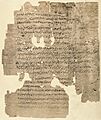Babrius facts for kids
Babrius (Greek: Βάβριος) was an ancient Greek writer who lived around the 2nd century AD. He is famous for writing a collection of Greek fables. Many of these short stories, which often teach a moral lesson, are now known as Aesop's Fables.
Contents
Who Was Babrius?
Not much is known about Babrius's life. People believe he was a Roman who had adopted Greek culture and language. His original name might have been Valerius. He probably lived in the eastern part of the Roman Empire, possibly in Syria. This is where his fables seem to have become popular first.
Some scholars think he might have been a teacher for a "son of King Alexander." This Alexander could have been Alexander Severus, a Roman emperor who ruled from AD 222 to 235. Emperor Alexander Severus liked to have writers and thinkers at his court. Babrius's writings are thought to be from before the year 200 AD.
Discovering His Fables
For a long time, Babrius was just a name. People knew he existed, but his full collection of fables was lost.
The 1842 Find
In 1842, a Greek scholar named Minoides Mynas made an exciting discovery. He found a manuscript of Babrius's fables in a monastery called Great Lavra on Mount Athos. This old book is now kept in the British Museum.
The manuscript contained 123 fables. It was thought that Babrius originally wrote about 160. The fables were arranged in alphabetical order, but the manuscript stopped at the letter O.
These fables were written in a special type of poetry called "choliambic" verse. This means they had a "limping" or uneven rhythm. The writing style was very good, with clear and sharp language. The stories themselves were put together just as well as the prose (non-poetic) versions of the fables. Scholars generally agreed that this collection was truly written by Babrius.
Later, in 1857, Mynas claimed to have found another manuscript with more fables. He made a copy, which was also sold to the British Museum. However, this second discovery was soon believed to be a fake. A few more fables were found in other old manuscripts later on.
Babrius's Legacy
Babrius's fables have been very important. They helped preserve many of the stories we know today as Aesop's Fables. His work shows how these ancient tales were told and passed down through generations. His fables have been translated into many languages, allowing people all over the world to enjoy their wisdom and lessons.
Images for kids
-
A third- or fourth-century papyrus containing a text of Babrius accompanied by Latin translation (P.Amherst II 26, column ii)
See also
 In Spanish: Babrio para niños
In Spanish: Babrio para niños



